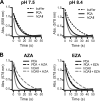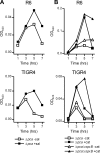Carbonic anhydrase is essential for Streptococcus pneumoniae growth in environmental ambient air
- PMID: 20525828
- PMCID: PMC2916381
- DOI: 10.1128/JB.00151-10
Carbonic anhydrase is essential for Streptococcus pneumoniae growth in environmental ambient air
Abstract
The respiratory tract pathogen Streptococcus pneumoniae needs to adapt to the different levels of carbon dioxide (CO(2)) it encounters during transmission, colonization, and infection. Since CO(2) is important for various cellular processes, factors that allow optimal CO(2) sequestering are likely to be important for pneumococcal growth and survival. In this study, we showed that the putative pneumococcal carbonic anhydrase (PCA) is essential for in vitro growth of S. pneumoniae under the CO(2)-poor conditions found in environmental ambient air. Enzymatic analysis showed that PCA catalyzes the reversible hydration of CO(2) to bicarbonate (HCO(3)(-)), an essential step to prevent the cellular release of CO(2). The addition of unsaturated fatty acids (UFAs) reversed the CO(2)-dependent in vitro growth inhibition of S. pneumoniae strains lacking the pca gene (Deltapca), indicating that PCA-mediated CO(2) fixation is at least associated with HCO(3)(-)-dependent de novo biosynthesis of UFAs. Besides being necessary for growth in environmental ambient conditions, PCA-mediated CO(2) fixation pathways appear to be required for intracellular survival in host cells. This effect was especially pronounced during invasion of human brain microvascular endothelial cells (HBMEC) and uptake by murine J774 macrophage cells but not during interaction of S. pneumoniae with Detroit 562 pharyngeal epithelial cells. Finally, the highly conserved pca gene was found to be invariably present in both CO(2)-independent and naturally circulating CO(2)-dependent strains, suggesting a conserved essential role for PCA and PCA-mediated CO(2) fixation pathways for pneumococcal growth and survival.
Figures





References
-
- Auzat, I., S. Chapuy-Regaud, G. Le Bras, D. Dos Santos, A. D. Ogunniyi, I. Le Thomas, J. R. Garel, J. C. Paton, and M. C. Trombe. 1999. The NADH oxidase of Streptococcus pneumoniae: its involvement in competence and virulence. Mol. Microbiol. 34:1018-1028. - PubMed
-
- Bahn, Y. S., G. M. Cox, J. R. Perfect, and J. Heitman. 2005. Carbonic anhydrase and CO2 sensing during Cryptococcus neoformans growth, differentiation, and virulence. Curr. Biol. 15:2013-2020. - PubMed
Publication types
MeSH terms
Substances
LinkOut - more resources
Full Text Sources

